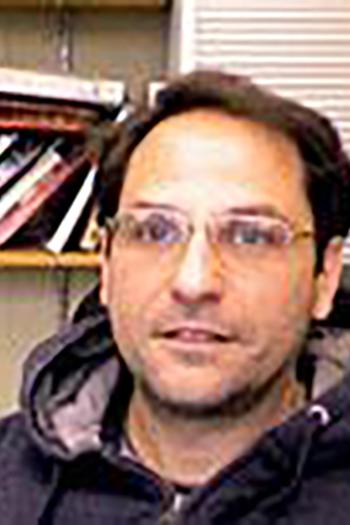Mauricio Terebiznik

Teaching Interests
Teaching
- BIOC17H: Microbiology; The Bacterial Cell
- BIOD17H: Seminars in Cellular Microbiology
- JBZ1018: Advanced Microscopy (graduate course)
Research Interests
Research Area: Microbiology, Cell and Molecular Biology
Keywords:
- Cellular microbiology
- Invasive bacteria
- Legionella
- Salmonella
- TLRs
- Dendritic cells
Current Research
My laboratory investigates the interplay between cells and intracellular pathogens, which could be viruses, bacteria, parasites, or fungi. These pathogens developed the capacity to invade cells and co-opt cellular mechanisms to invade hosts amicable for their replication. Indeed, inside host cells, intracellular pathogens replicate safely, hide from the immune system, and can spread systemically, ultimately causing disease. To take over host cells, intracellular pathogens rely on a myriad of molecular tools that interfere with and modify cellular pathways and structures. For this reason, intracellular pathogens are regarded as master cell biologists from which we can learn about our own cellular and molecular pathways. By studying their strategies, we can gain an understanding of not only virulence mechanisms but also how our cells work and how they detect and fight intracellular infections. My laboratory investigates these matters, specifically how intracellular pathogens hijack different cells in our body. We also investigate how intracellular pathogens deal with phagocytosis in macrophages, a process by which these immune cells ingest and kill pathogens. We are particularly interested in how pathogens' size and morphology may condition different aspects of phagocytosis.
Publications
1
Aluminum hydroxide adjuvant diverts the uptake and trafficking of genetically detoxified pertussis toxin to lysosomes in macrophages.
Jaldin-Fincati J, Moussaoui S, Gimenez MC, Ho CY, Lancaster CE, Botelho R, Ausar F, Brookes R, Terebiznik M.
Mol Microbiol. 2022 May;117(5):1173-1195. doi: 10.1111/mmi.14900. Epub 2022 Apr 7.
PMID: 35344242 Free PMC article.
2.
Rab1b-GBF1-ARF1 Secretory Pathway Axis Is Required for Birnavirus Replication.
Gimenez MC, Frontini-Lopez YR, Pocognoni CA, Roldán JS, García Samartino C, Uhart M, Colombo MI, Terebiznik MR, Delgui LR.
J Virol. 2022 Feb 23;96(4):e0200521. doi: 10.1128/JVI.02005-21. Epub 2021 Dec 8.
PMID: 34878889 Free PMC article.
3.
Phagosome resolution regenerates lysosomes and maintains the degradative capacity in phagocytes.
Lancaster CE, Fountain A, Dayam RM, Somerville E, Sheth J, Jacobelli V, Somerville A, Terebiznik MR, Botelho RJ.
J Cell Biol. 2021 Sep 6;220(9):e202005072. doi: 10.1083/jcb.202005072. Epub 2021 Jun 28.
PMID: 34180943 Free PMC article.
4.
Phosphatidylinositol 3-Phosphate Mediates the Establishment of Infectious Bursal Disease Virus Replication Complexes in Association with Early Endosomes.
Gimenez MC, Issa M, Sheth J, Colombo MI, Terebiznik MR, Delgui LR.
J Virol. 2021 Feb 24;95(6):e02313-20. doi: 10.1128/JVI.02313-20. Print 2021 Feb 24.
PMID: 33361427 Free PMC article.
5.
Polymorphisms of a Collagen-Like Adhesin Contributes to Legionella pneumophila Adhesion, Biofilm Formation Capacity and Clinical Prevalence.
Abdel-Nour M, Su H, Duncan C, Li S, Raju D, Shamoun F, Valton M, Ginevra C, Jarraud S, Guyard C, Kerman K, Terebiznik MR.
Front Microbiol. 2019 Apr 5;10:604. doi: 10.3389/fmicb.2019.00604. eCollection 2019.
PMID: 31024468 Free PMC article.
6.
Small Rho GTPases and the Effector VipA Mediate the Invasion of Epithelial Cells by Filamentous Legionella pneumophila.
Prashar A, Ortiz ME, Lucarelli S, Barker E, Tabatabeiyazdi Z, Shamoun F, Raju D, Antonescu C, Guyard C, Terebiznik MR.
Front Cell Infect Microbiol. 2018 May 3;8:133. doi: 10.3389/fcimb.2018.00133. eCollection 2018.
PMID: 29774203 Free PMC article.
7.
Phagocytosis: what's on the menu? 1.
Lancaster CE, Ho CY, Hipolito VEB, Botelho RJ, Terebiznik MR.
Biochem Cell Biol. 2019 Feb;97(1):21-29. doi: 10.1139/bcb-2018-0008. Epub 2018 May 23.
PMID: 29791809 Review.
8.
pH of endophagosomes controls association of their membranes with Vps34 and PtdIns(3)P levels.
Naufer A, Hipolito VEB, Ganesan S, Prashar A, Zaremberg V, Botelho RJ, Terebiznik MR.
J Cell Biol. 2018 Jan 2;217(1):329-346. doi: 10.1083/jcb.201702179. Epub 2017 Oct 31.
PMID: 29089378 Free PMC article.
9.
Legionella pneumophila: homeward bound away from the phagosome.
Prashar A, Terebiznik MR.
Curr Opin Microbiol. 2015 Feb;23:86-93. doi: 10.1016/j.mib.2014.11.008. Epub 2014 Nov 27.
PMID: 25461578 Review.
10.
Filamentous morphology of bacteria delays the timing of phagosome morphogenesis in macrophages.
Prashar A, Bhatia S, Gigliozzi D, Martin T, Duncan C, Guyard C, Terebiznik MR.
J Cell Biol. 2013 Dec 23;203(6):1081-97. doi: 10.1083/jcb.201304095.
PMID: 24368810 Free PMC article.
11.
Mechanism of invasion of lung epithelial cells by filamentous Legionella pneumophila.
Prashar A, Bhatia S, Tabatabaeiyazdi Z, Duncan C, Garduño RA, Tang P, Low DE, Guyard C, Terebiznik MR.
Cell Microbiol. 2012 Oct;14(10):1632-55. doi: 10.1111/j.1462-5822.2012.01828.x. Epub 2012 Jul 9.
PMID: 22727141
12.
Comparative Genomics Reveal That Host-Innate Immune Responses Influence the Clinical Prevalence of Legionella pneumophila Serogroups.
Khan MA, Knox N, Prashar A, Alexander D, Abdel-Nour M, Duncan C, Tang P, Amatullah H, Dos Santos CC, Tijet N, Low DE, Pourcel C, Van Domselaar G, Terebiznik M, Ensminger AW, Guyard C.
PLoS One. 2013 Jun 27;8(6):e67298. doi: 10.1371/journal.pone.0067298. Print 2013.
PMID: 23826259 Free PMC article.
13.
Effect of Helicobacter pylori's vacuolating cytotoxin on the autophagy pathway in gastric epithelial cells.
Terebiznik MR, Raju D, Vázquez CL, Torbricki K, Kulkarni R, Blanke SR, Yoshimori T, Colombo MI, Jones NL.
Autophagy. 2009 Apr;5(3):370-9. doi: 10.4161/auto.5.3.7663. Epub 2009 Apr 19.
PMID: 19164948